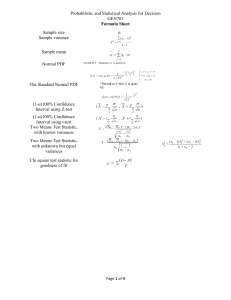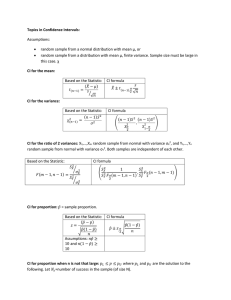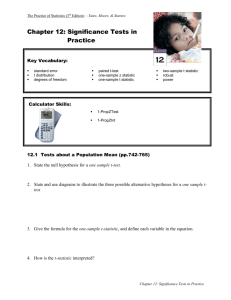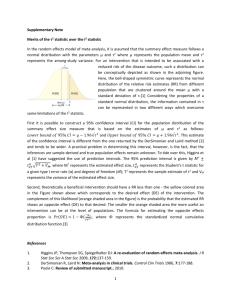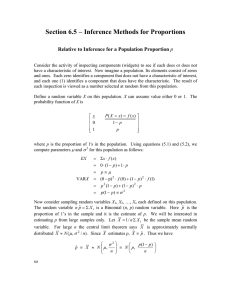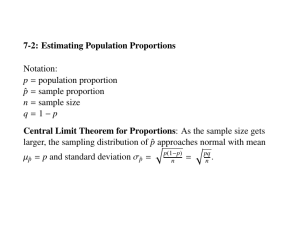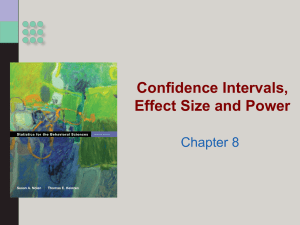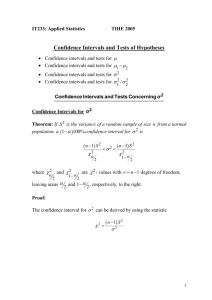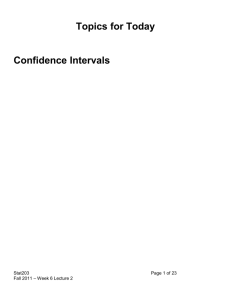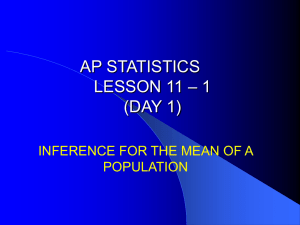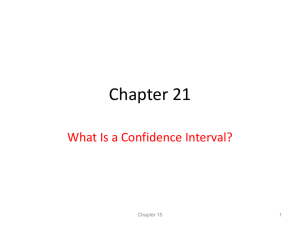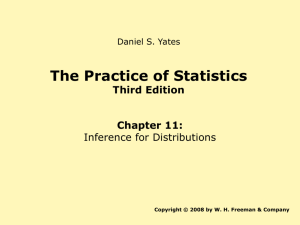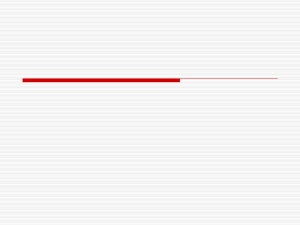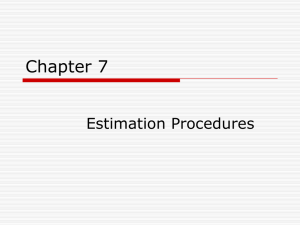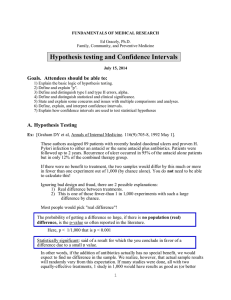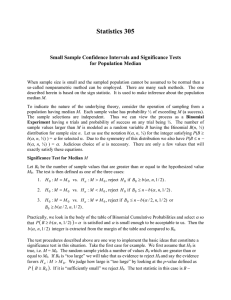Tentative Formula Sheet
advertisement
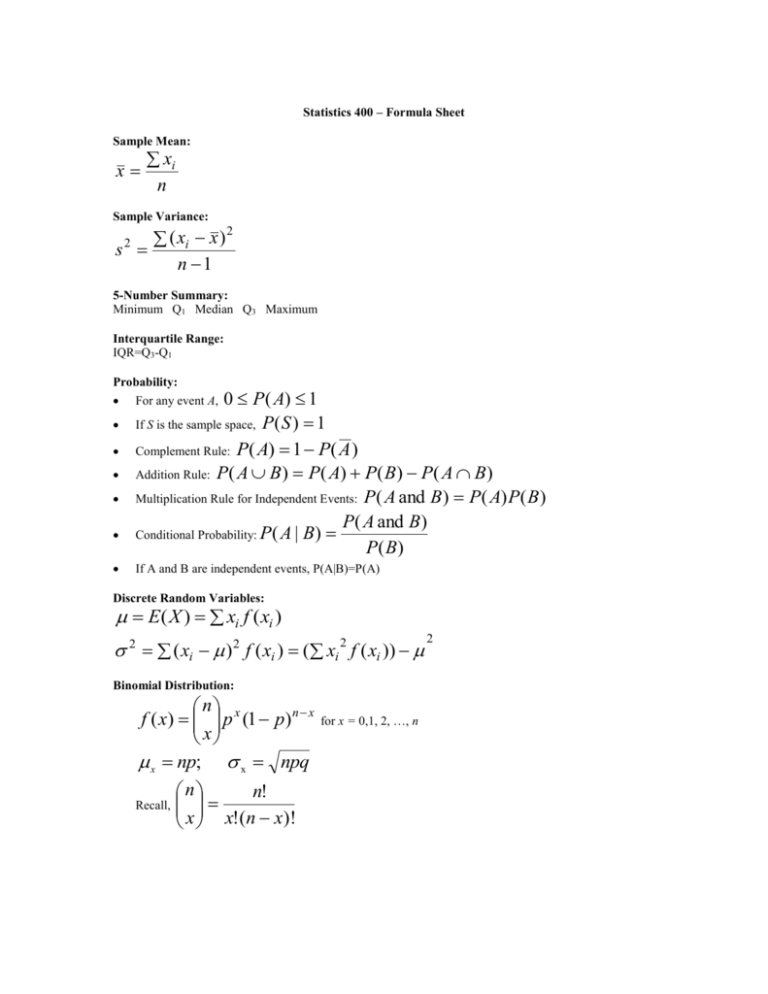
Statistics 400 – Formula Sheet Sample Mean: x xi n Sample Variance: 2 ( xi x ) s n 1 2 5-Number Summary: Minimum Q1 Median Q3 Maximum Interquartile Range: IQR=Q3-Q1 Probability: 0 P ( A) 1 If S is the sample space, P ( S ) 1 Complement Rule: P( A) 1 P( A ) Addition Rule: P ( A B ) P ( A) P ( B ) P ( A B ) Multiplication Rule for Independent Events: P ( A and B ) P ( A) P ( B ) P( A and B) Conditional Probability: P ( A | B ) P( B) For any event A, If A and B are independent events, P(A|B)=P(A) Discrete Random Variables: E( X ) xi f ( xi ) 2 ( xi ) 2 f ( xi ) ( xi 2 f ( xi )) Binomial Distribution: n f ( x) p x (1 p) n x x x np; x npq n n! Recall, x x!(n x)! for x = 0,1, 2, …, n 2 Z-Transformation: Z x Inference for the Population Mean: Sample Size for a desired Margin of Error, d, for samples from a normal population: 2 z / 2 n d Large Sample Confidence Intervals x z / 2 x z / 2 when is known n s when is unknown n Small Sample Confidence Intervals s x t / 2 n Independent Sample Confidence Intervals 1 1 ( x x ) t s 1 2 /2 p n n2 1 Inference for the Population Proportions: Large Sample Confidence Interval for a Proportion: (use p=q=.5 for conservative CI) pˆ z / 2 Large Sample Test Statistic for a Proportion: Z pq n pˆ p0 p0 q0 / n Small Sample Test Statistic for a Proportion: X = number of successes. If H0 is true, X has a binomial distribution with parameters p0 and n. 2 Sample Size for Desired Margin of Error m: z* * n p (1 p * ) d T-statistics: x 0 t s / n x1 x2 Two Sample t-statistic: t 1 1 sp n n2 1 One-Sample t-statistic: Pooled sample variance: df=n-1 df=n1+n2-2 (n1 1) s12 (n2 1) s22 2 s p n1 n2 2 Correlation and Regression: Correlation: r 1 xi x yi y n sx s y Linear Regression Model: yi 0 1xi i Parameter Estimators: ̂1 r sy sx , where i is N 0, ˆ0 y ˆ1 x ei yi yˆ i = observed y – predicted y Residuals: Estimate of : e 2 i s MSE A Level C confidence Interval for s where SE b1 x 1 is given by: ˆ1 t *SE ( ˆ1 ) * x 2 i n2 and t is the value for the t n 2 density curve with area C between t and t . * * H 0 : 1 10 , ˆ1 10 the test statistic is t which has a t n 2 distribution under SE ( ˆ1 ) t Test for 1 To test H0 1 Standard error of the intercept 1 x2 ˆ 0 : SE ( 0 ) s n xi x 2 H 0 : 0 00 , ˆ0 00 the test statistic is t SE ( ˆ0 ) T-Test for 0 To test 1 which has a t n 2 distribution under H 0 Estimated Mean Response ˆ y ˆ0 ˆ1 x * A Level C Confidence Interval for the Mean Response is given by: where 1 ( x* x ) 2 SE ( ˆ y ) s n xi x 2 ˆ0 ˆ1 x * t * SE ( ˆ y ) * and t is the value for the t n 2 density curve with area C between t and t . * * Predicted Value of the Response Variable yˆ ˆ0 ˆ1 x* A Level C Prediction Interval for an Individual Response is given by: where 1 ( x* x ) 2 SE ( yˆ ) s 1 n xi x 2 ˆ0 ˆ1 x* t * SE( yˆ ) and t* is the value for the t n 2 density curve with area C between t and t . * * Chi-Square Tests: Test of Independence Independence Hypothesis H 0 : There is no relationship between the row variable and the column variable. Expected Cell Counts Test Statistic 2 E expected row total column tot al Overall total (observed expected ) 2 expected which has the 2 distribution with (r 1)(c 1) degrees of freedom under.
